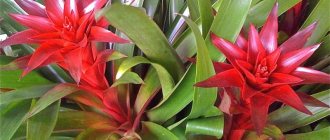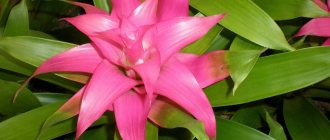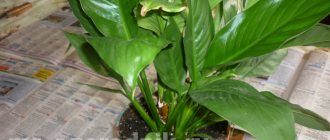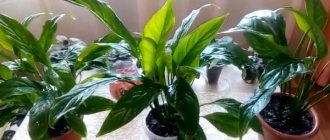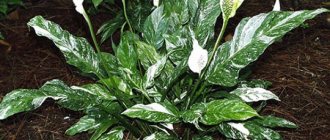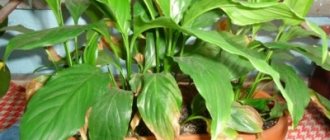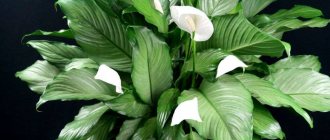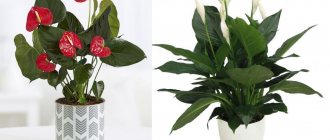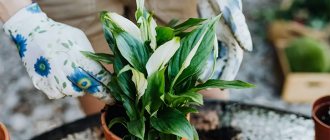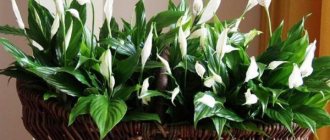The spathiphyllum plant was described in detail by the botanist G. Wallis in the 19th century. In nature, the culture is located on the shore along various bodies of water, on slightly acidic soil, in the undergrowth of regions with a tropical climate. New breeding varieties, bred since the mid-60s of the last century, attract flower growers with various shades, shapes, sizes, and the presence of a light aroma.
Description
“Women's happiness” is what the common people call spathiphyllum. The culture is part of the araceae family, maintaining foliage all year round. The leaf plates of the flower are oval, elongated, lanceolate, with visible veins, the outer side of the leaf is glossy. The culture has a short stem, creeping along the ground, which gives the impression that spathiphyllum leaves are growing directly from the ground.
A peculiarity of the appearance of the crop during the flowering period is the inflorescence, consisting of an oblong-shaped spadix, covered with tubercles, and a light white bract called the spathe.
Indoor spathiphyllum is represented by hybrid forms of wild varieties of the crop. It is used for landscaping at home, work premises, and in landscape compositions.
On Russian windows there are common species Spathiphyllum Floribundum, Spathiphyllum Wallisii.
Description of similar plants
Let's get acquainted with the description of flowers that are similar to our Spathiphyllum:
Anthurium
A gorgeous flower, which is popularly called “male happiness ,” which means that both plants should grow in the apartment, then a favorable harmonious atmosphere in the family is guaranteed; in this flower (also from the tropics) the inflorescence is a spadix, and the dense bract is juicy red; the conditions of its maintenance and rules of care are similar to Spathiphyllum.
Calla
A very elegant flower (also from the Araceae family), widely distributed at home, many varieties with flowers of different shades have been bred; the shape of the leaves and flower is also very similar to the structure of Spathiphyllum.
Main types
Among the many shapes and colors of spathiphyllum, classic varieties of the flower stand out, from which breeders have developed numerous hybrid varieties.
profusely blooming
Spathiphyllum Floribundum - with light leaves, the petiole of the plate is about 10 cm. The leaf grows up to 20 cm in length, the young shoots are bright, light in comparison with mature shoots. Peduncles are located above the leaf mass. The perianth is small, the average size is 5 cm, light white. The culture is characterized by long flowering every year.
Nice
Spathiphyllum Blandum is distinguished by the structure of its leaf blade. A large crop growing in Suriname, the leaves are elliptical, veins stand out on the surface of the plate. The length of the leaf reaches 32 cm. The petioles are elongated, proportionate to the leaves, and are attached to the creeping underground stem of the flower.
The bract is equal in length to the leaf; at the end of the peduncle there is an inflorescence of pale yellow color.
Pleasant spathiphyllum blooms regularly; when in favorable home conditions, it is capable of repeated constant flowering.
Cannofolia
Spathiphyllum Cannifolium is characterized by narrow, long leaves (40 cm). The bract is white, the inner side is painted in a greenish tint, up to 22 cm long. The spathe is on average several times larger than the size of the spadix, and is colored yellowish-white. The peculiarity of Spathiphyllum cannofolia is the presence of a pronounced aroma and a modified structure of the cob, which has a smooth structure. In the wild, spathiphyllum is found in tropical forests, as well as in Trinidad, South America.
Spoon-shaped
Spathiphyllum Cochlearispathum was discovered in Brazil. The flower reaches a meter in height, with shiny oblong leaves. The width of the leaf plate is 10-15 cm, length 35-40 cm, the color is emerald green. The petioles of the leaf blades are elongated and can reach 70 cm in length. Spathiphyllum received its name because of the shape of the bedspread, which externally resembles the concave shape of a spoon. The cover is a classic white color; the cob turns dark green as it ripens.
Wallis
Spathiphyllum Wallisii is named after its discoverer, G. Wallis. The culture is considered unpretentious in care, which is why it is widespread. The wild plant became the progenitor of modern varieties of domestic flowers. Spathiphyllum Wallis is small in size, the maximum height is 40 cm, which gives it an advantage for growing in apartment conditions.
A native of Colombia produces oblong leaves. The petioles are flexible; over time, their shape becomes more sinuous, causing the leaves to take an inclined position. The inflorescences are up to 5 cm in length, wrapped in a white or greenish “hood”; as the cob ripens, the veil turns completely green. The ear itself is pale yellow, then turns green.
A characteristic feature of Spathiphyllum Wallis is its long flowering, beginning in spring and ending in autumn.
Heliconifolia
A large variety of spathiphyllum, with rich dark green leaf blades. The plant can grow up to 100-120 cm in height. The leaves are glossy, pleasant, oblong, up to 25 cm wide, up to half a meter long, the edge of the leaf blade has a wavy shape. The inflorescence is large, up to 10 cm, white, darkens during ripening. The spathe is larger than a cob, white, oval.
The petioles are on average a meter long. The plant prefers diffused light, constant sprinkling with warm water, and moderate watering. Capable of growing in a shaded area. These qualities make it possible to grow the crop at home without any problems.
Plant varieties with photos
What are the names of spathiphyllums that have scarlet inflorescences? Their name is anthuriums or “male happiness”. Below are the varieties of anthurium and photos of them.
Dakota
The most popular species among gardeners . It stands out from all the others thanks to the rather large size of the inflorescence covers - 14 - 23 cm. Spectacular flowers of bright color combined with lush dark green leaves simply cannot be ignored even in a spacious room.
Next is a video about the Dakota variety:
Minnesota
Their distinctive feature is the bracts of a rich scarlet color and the cobs, which are white at the base, gradually turning into bright yellow, sometimes green.
This variety includes many types of anthriums that have very rich bright red or pink covers (for example, Edison).
Dark Red
Their color palette includes all shades from bright red to brown and even black. Burgundy and crimson colors look especially impressive .
Next is a video about the Dark Red variety:
Black queen
Against the background of the almost white spadix, the bract looks almost black. Against a dark background, all the veins stand out very clearly, which makes its appearance even more attractive and impressive.
Next is a video about the Black Queen variety:
Classification of varieties
These varieties are hybrids of classical crops and real wild plants, intended for growing at home. They are distinguished by increased decorativeness, various shapes and a long flowering period. Plants get their names from the place where the variety originated; some crops are named after great people.
Mauna Loa
Spathiphyllum is native to Colombia. "Mauna Loa" is a crop with an elliptical, concave perianth that protects a tiny ear. The leaves are pointed. The stem is short, underground. Peduncles are located above the foliage, the average shoot length is 22 cm. The flowering period is long, sometimes constant. Cut flowers retain their original appearance for a long time when placed in a container of water.
"Chopin"
Spathiphyllum Chopin is a common crop for landscaping areas and premises for various purposes. The size of the bush reaches 42 cm. The leaf blades are shiny on the outside, the veins are easily visible, the tip forms a sharp spine. Perianth in white tones, elongated.
In the first half of the day, the culture spreads a subtle aroma, making the flower even more attractive to gardeners.
"Domino"
Spathiphyllum Domino is a variegated variety, the leaf blades are colored with whitish-milky, green stripes. To maintain variegated foliage, the crop should be placed in areas where plenty of indirect sunlight is available. When kept in the shade, the leaf blades lose their pattern and become uniformly colored green. “Domino” is a low-growing bush, no more than 30 cm in height, emits a light aroma in the morning, is moisture-loving, and is afraid of drafts.
"Picasso"
Dutch hybrid variegated variety, bred from Spathiphyllum Wallis. Milky shades cover a large area of the leaf plate. Since “Picasso” is a variegated variety, the crop requires careful care and sufficient lighting.
"Sensation"
Tall ornamental bushes (150 cm) with large dark leaves. The size of the leaf plate exceeds 70 cm in length. Large inflorescences of "Sensation" of a dazzling snow-white tone eventually turn greenish. The cob is smooth. Flowers retain their decorative properties for a long time after being cut.
"Sweet Silvio"
A lush hybrid about 75 cm high. The inflorescences have an elegant shape. It is used for multi-level decorative landscaping, placing the crop after miniature varieties, for example, “Strauss”, which grows no higher than 30 cm.
"Alana"
A massive crop half a meter high. The leaves are practically erect and do not droop as they grow. The leaf blade is dense to the touch, green in color. The bract on the back side has a vein that colors the center of the spathe light green.
"Cupido"
'Cupido' is a Spathiphyllum Wallis grown in the Netherlands. The plant has emerald foliage, the inflorescence covers are gracefully concave. The culture is unpretentious in handling and is suitable for beginner flower growers to get acquainted with the flower.
"Verdi"
A medium-sized plant, maximum height 70 cm. The crop is sun-loving, but with prolonged exposure to rays, burns form on parts of the plant. Easy to care for. The temperature regime for keeping “Verdi” in the summer season is 24-27 degrees Celsius, in the winter season – no higher than +16. Does not tolerate drafts or sudden temperature changes. Requires moderate watering.
"Haiti"
A rare variety, fastidious in care, needs timely watering and constant feeding. The bush is not tall, it is a dwarf species, the leaves are slightly drooping, the central vein is light green. Peduncles are standard, rise above the total mass of foliage or are at the same level with it. The bedspread is snow-white. The ear is tuberculate, cream-colored.
Japanese
An undemanding bush with elongated peduncles. Japanese spathiphyllum blooms twice a year; the inflorescences are capable of thinning out a faint, pleasant aroma. The foliage is bright emerald, drooping, with visible veins, the edge of the leaf blade is wavy. The length of the peduncle is 50-70 cm, the spadix is tuberculate, the bract is light, elongated oval, with a noticeable light green vein in the center.
"Sweet Lauretta"
The variety was born in 2001. The bush is lush, the width is almost equal to the height - 80 cm. The flowering period begins a month after the rooting of the petiole. The leaf blades are elliptical, no more than 35 cm long. The cover is large, the size of a palm.
This variety is used as a single plant for landscaping home and other premises.
"Gemini"
A lush variegated variety, leaves with sharp ends have dark and light spots in green tones, the edge of the plate is curved. Demanding of sunlight and care.
"Strauss"
A dwarf variety whose height does not exceed 30 cm. The leaf blades are elongated, the bract is a classic white color. The flowering period occurs twice a year. It looks organic in single and group plantings, tolerates partial shade, and needs diffused lighting.
"Sweet Chico"
The main feature of “Sweet Chico” is the absence of a stem. The height of the crop is about 70 cm. The leaves are large, grow directly from the root, and are located on erect petioles. The outer side of the leaf is glossy, covered with straight veins. Peduncles emerge from the soil mixture. During the flowering period, the bush is abundantly strewn with flower stalks. The spadix is pale, the bract is snow-white, elongated, after a while the color changes to greenish.
Royal
In other words, gigantic. The culture is massive, the maximum height of the royal spathiphyllum is 150 cm. The leaves are elongated, the width is half the length. The leaf blades are thick, rich dark emerald in color, the edges are curved, the front side is shiny. The inflorescence consists of a tuberculate spadix and an oval white perianth.
To size
Based on size criteria, crops are divided into component groups consisting of varieties that meet the requirements of the category.
The most massive representatives: spathiphyllum spoon-shaped, gigantic or royal, variety “Sensation”, heliconifolia. A large, large bush is suitable for any area and premises.
Medium - varieties “Sweet Lauretta”, “Sweet Chico”, “Alana”.
Dwarf or mini varieties of spathiphyllum are specially bred for home use. They are distinguished by the elongated shape of the bush, without drooping leaves. Low-growing varieties are unpretentious in care, rarely get sick, and bloom profusely and for a long time. Miniatures include: Strauss, Haiti, Domino, Chopin and others.
By color
It is widely believed that spathiphyllum inflorescences, in addition to their white color, have a pink or red tint. Actually this is not true. Before buying a “red” rare spathiphyllum, you should understand the classification of the crop.
Dyeing the bedspread is only possible using artificial dyes. In all types of spathiphyllum (hybrid and true), the bract can only become green. Crops that are closely related to the plant have colored perianths. Such a relative is anthurium. The bred varieties allowed anthuriums to have pink, burgundy, and red bracts of different saturations. Externally, the flowers are similar to each other, but in the latter crop it is dense, flat, semicircular in shape, almost completely open, with pronounced veins.
In the West, both plants have a common name - Peace Lily. Therefore, when purchasing a rare specimen, you should carefully examine the plant.
Problems when growing spathiphyllum
Houseplants can get sick even with the best care. It depends on various reasons. It is important to take appropriate measures in time to save the plant.
Why don't flowers appear?
If your plant is not blooming, there could be several reasons.
- Low room temperature;
- Dry air;
- Lack of feeding.
Spray the flower regularly, place it in a warmer place, and apply mineral and organic fertilizers. After a short period of time, the snow-white curved leaves of the flower will bloom on the windowsill. It should also be taken into account that too old spathiphyllums bloom extremely rarely.
The leaves have turned black
If blackness appears on the leaves, this indicates that the root system is beginning to die. This problem occurs in the following cases:
- If you adhere to the wrong watering regime. The leaves turn black when the soil is too dry, but also if you grow a real “swamp” in a pot;
- There is not enough nitrogen or phosphorus for normal development;
- The leaves are sprayed in a cold room.
To prevent the death of the plant, remove it from the pot and remove rotten roots. Then they are transplanted into another container with a previously prepared earthen substrate.
The leaves have turned yellow
If the tips of the leaves begin to dry out and turn yellow, this indicates insufficient watering. Weekly bathing will help correct this problem. This procedure is useful not only for returning the leaves to their normal color, but also as a pest control.
When the leaves of the spathiphyllum begin to wither before our eyes, it is still possible to save it. You can’t immediately fill it with too much water. The soil is “soaked” gradually. After this, they begin to spray the drooping leaves or gently wipe them with a sponge soaked in water.
Place the pot in a tray filled with wet litter. Be sure to make sure that the yellowing of the leaves has not been caused by a pest attack.
How to choose?
On the shelves of flower shops, all the flowers look healthy and attract attention. However, external appearances can be deceiving; you should not take the first flower pot you come across.
Let's figure out what you should pay attention to.
- Leaves. Leaf blades of a healthy crop do not have mechanical or other damage or defects, and are evenly colored green, with the exception of variegated varieties. There are no spots of any color, the leaf is dense, juicy, glossy.
- Shoots and inflorescences. Petioles, peduncles, cobs, perianths are not damaged. The shoots are dense to the touch. Cob covers without signs of wilting or dry tips.
- The soil. Be sure to inspect the ground in which the plant is located. You can slightly pull the crop up from the temporary pot to inspect the condition of the root system and how filled the earthen ball is with roots. The soil should not emit unpleasant odors or be flooded. The surface layers of the soil should not contain traces of mold, insect activity - cobwebs, “fluffy” deposits.
How it blooms: photo of home culture
The flowering period of drimiopsis occurs at the end of February and the plant blooms for 3 months. If you properly care for the flower, it will delight you with the formation of new buds in early September.
Drimiopsis has inconspicuous flowers of various white shades, which are collected in small inflorescences located on a long and flexible peduncle. The size of the opened flowers in diameter does not exceed 5 mm. They open gradually from bottom to top. The aroma of flowers is similar to the smell of lilies of the valley.
A flower is formed from a small rosette. Its leaves grow on small petioles. The bulbs are oblong green in color. They do not sink completely into the soil.
The following are photos of flowering:
Beautiful examples
In residential premises, culture acts as a decorative item. Plants are planted in snow-white pots of various geometric shapes, emphasizing the color of the bracts and highlighting the rich tone of the foliage.
Flowers can be planted in groups in wide planting containers. This method is used to visually divide space into zones in residential and office premises, as a decoration for various massive interior items: dining tables, chests of drawers, and so on.
In landscape design, spathiphyllums act as a border or flower arrangement. They require high-quality soil drainage, its composition and care as the plant grows.
An overview of the types of spathiphyllum is presented in the following video.
Spathiphyllum is a stemless perennial from the tropics. Most flowers similar to spathiphyllum belong to the araceae family. This group includes decorative foliage and beautiful flowering plants.
Varieties of spathiphyllum
• Anthurium or red spathiphyllum
Reproduction • Caring for spathiphyllum • Plant transplantation • Spathiphyllum at home • Watering Diseases and pests of spathiphyllum • Spathiphyllum turns yellow • Spathiphyllum does not bloom Notes from gardeners
The name of the flower consists of two words: spatha and phyllum, which from Greek means “spread” and “leaf”. They successfully characterized the shape of the flower, resembling a blanket at the very base of a cob on a long stalk.
Varieties of spathiphyllum
The breeding of varieties of spathiphyllum - monocotyledonous flowering plants from the aroid family (Araceae), growing in the tropical regions of North and South America, as well as Southeast Asia, began relatively recently - in the 60s of the last century. Today, florists and breeders name about 40 types of flowers. Some species of spathiphyllum are known as spath or "peace lilies". These are evergreen herbaceous perennial plants with large leaves 12-65 cm long and 3-25 cm wide. The base of the cob is wrapped in a white, yellowish or greenish blanket 10-30 cm long. The plant does not require a lot of light and water. An important factor is some toxicity of the plant containing calcium oxalate crystals, which can cause skin irritation, burning in the mouth, difficulty swallowing, and nausea.
Description and photo of plants similar to spathiphyllum
Indoor flowers of the Aronia family attract attention with large leaves of an original shape and often of an unusual color. Many of them bloom beautifully with peculiar cobs, covered with a leaf-spread of various shades.
Anthurium
Anthurium is a plant with a very impressive appearance. Anthurium leaves are large, leathery, cut or whole. The leaf size ranges from several centimeters to one meter in length. The leaves have a velvety sheen and a silvery sheen on the veins. The leaves of some types of anthurium are decorated with an ornamental pattern created by veins.
The flowers of the plant are extremely beautiful and original in shape. They are collected in an inflorescence-cob of a tubular or tail-shaped form. The spadix is shrouded in a pink or red bract. In some species the spathe is light green or bluish-blue.
Calla
Calla is a herbaceous perennial native to South Africa that blooms in winter or early spring with elegant and even dainty flowers on elongated peduncles. The inflorescence is a spadix covered with a leaf-spread, gracefully wrapped around.
The shade of the bedspread is varied: yellow, white, lilac, pinkish, blue, purple and even blue-black. In most varieties, the color of the spathe is iridescent, from darker at the base to lighter closer to the edge.
Alocasia
Alocasia is a rare exotic plant native to the tropics of Southeast Asia. In indoor conditions it practically does not bloom, therefore it is classified as an ornamental deciduous plant. Alocasia leaves are oval, with sharp tips and clearly defined veins of contrasting color. There are varieties with striped leaves.
The length of the leaf reaches the plant 50 centimeters, and the height is 150 centimeters. In the wild, alocasia can grow up to 3 meters in height and produce leaves up to 1 meter in diameter. In natural conditions, alocasia is a plant with white flowers that have a delicate aroma. Small flowers are collected in neat inflorescences of pale pink color.
Aglaonema
Aglaonema is an indoor ornamental foliage plant from China, India or Southeast Asia. The shape of the foliage and flowering of aglaonema is similar to spathiphyllum. But the color of the leaves of Aglaonema is variegated, and the inflorescence-cob is covered not with white, but with a greenish blanket. The ears of the plant are thin, cylindrical or thick, club-shaped.
The height of agloanema reaches 70 centimeters. There are six types of plants grown at home: curly, painted, ribbed, changeable, moderate and shiny. The shape of the leaves of the plant is lanceolate or oblong. The color is reddish, green with stripes and spots.
Monstera
Monstera is a perennial herbaceous vine with thick stems and large leaves with spectacular holes. The young leaves of Monstera are whole; slits appear on them only as the plants grow. At home, the length of the leaves reaches 30-40 centimeters; in natural conditions it can be much longer.
By nature, Monstera is a vine, but at home it is grown as a plant with erect stems. Monstera flowering indoors is very rare. The flower is a spadix covered with a snow-white blanket, but it can only be seen in its natural environment.
Caladium
Caladium is a plant common in Brazil, South and Central America. The main advantage of this plant is its highly decorative leaves of various colors.
The leaves contain shades of red, pink, green, yellow-green, and white. The leaf plate is decorated with various veins, a contrasting edging along the edge or an impressive mesh.
Caladium flowers are inconspicuous: small cobs collected in small inflorescences. The cobs are covered with a white blanket.
Whitewing
Marsh calla lily (marsh calla) is a conspicuous inhabitant of lake shores and wetlands. The natural habitat of the plant is the climatic zone of the Northern Hemisphere. The height of the whitewing is from 15 to 50 centimeters. The plant is unpretentious, and if there is enough moisture, it can live even at sub-zero temperatures.
Whitewing leaves are wide at the core and pointed at the ends. The surface of the leaf plate is smooth, shiny, with prominent silver veins. Leaves are formed directly from the rhizome. Their length is from 5 to 11 centimeters.
The whitewing flower grows from the leaf axils. It is a vertical ear of yellow-green color with a snow-white inside and green outside covering leaf.
Eucharis
Eucharis (or Amazon lily) is a plant of the amaryllis family. Its leaves are completely identical to spathiphyllum, and until the moment of flowering these two plants can be completely confused. But the flowering of the two plants is completely different.
Eucharis blooms with snow-white bells, collected in inflorescences of 4-5 pieces. They are located on a tall peduncle rising from the center of a leaf rosette. Skilled flower growers achieve flowering of eucharis twice a year.
The flowers are large, 10 centimeters in diameter. Snow-white petals are pointed at the tips. In the center of the flower there is a greenish-yellow crown with a jagged edge, which gives the flower a resemblance to a daffodil.
Aspidistra
Aspidistra is an alien from the shady subtropical forests of Japan and southern China. In Russia it has long been grown as a houseplant. Aspidistra achieves high decorativeness due to the large number of leaves, wide at the base and pointed at the tips, growing directly from the soil.
The color of the leaves of the plant is dark or light green, in some species with longitudinal cream stripes.
The flowers of the plant are quite modest: they resemble small dark purple spiders located almost at the base of the leaves. They appear on the plant only in conditions as close as possible to natural ones.
It is quite difficult to achieve such compliance with the tropical climate in indoor conditions, so aspidistra flowering is a rare occurrence.
Spathiphyllum was first discovered and described by the German botanist and enthusiast Gustav Wallis back in the 19th century. The plants that attracted the attention of the scientist are still common in Colombia and other countries in the region. Many spathiphyllums can be seen along the swampy shores of reservoirs, in the undergrowth of tropical rainforests.
The plant, which came to the USA and Europe, attracted the attention of flower growers. As an indoor plant, spathiphyllum has become well known throughout the world. But breeding work to develop new varieties and hybrids began relatively recently, only in the mid-60s of the last century.
The appearance of plants suitable for growing indoors:
- dwarf and impressive sizes;
- with leaves of various shapes and colors;
- having a pleasant smell;
- capable of blooming for a long time and almost constantly, caused a serious increase in interest in the culture.
Today, amateur flower growers have dozens of varieties of spathiphyllum at their disposal, photos of which allow them to constantly be amazed at the diversity of nature.
Diseases and pests
Like every plant, our flower also sometimes has troubles and illnesses:
- The leaves turn black - this usually happens due to an excess of moisture, when the roots have already deteriorated, that is, the plant has been flooded for too long.
If you find an error, please select a piece of text and press Ctrl+Enter.
The spathiphyllum plant was described in detail by the botanist G. Wallis in the 19th century. In nature, the culture is located on the shore along various bodies of water, on slightly acidic soil, in the undergrowth of regions with a tropical climate. New breeding varieties, bred since the mid-60s of the last century, attract flower growers with various shades, shapes, sizes, and the presence of a light aroma.
Features and photo of spathiphyllum flower
Spathiphyllum, like many plants living in tropical and subtropical zones, does not shed its leaves all year round, remaining green and attractive. The leaves of the plant are quite large, elongated-lanceolate, with depressed veins and a glossy surface.
Since spathiphyllum has practically no stem, or it is very shortened and spreads along the ground, the leaves rise directly from the ground. And during the flowering period, graceful peduncles with white bracts surrounding a white or yellowish cob rise above the plants. Contrary to popular belief, the photo shows not a spathiphyllum flower, but its inflorescence. But small flowers collected in a cob have neither petals nor external attractiveness.
Therefore, during the course of evolution, the plant acquired a white and then green bract. It is like a flag, attracting the attention of insects. Today, botanists know more than four dozen species of spathiphyllum. Only a few varieties are used as indoor crops and for landscaping. The most common inhabitants of window sills are plants belonging to the species Spathiphyllum Floribundum and Wallisii.
Benefits and harms
From a scientific point of view, the plant perfectly cleanses the air of harmful impurities for humans and saturates it with ozone; if there are 4 plants in the room, then there will be the purest, almost mountain air. According to Feng Shui, this plant is very useful to keep in the house, but it is forbidden to give it away or give it to anyone; this should not be done under any circumstances - otherwise happiness will “leave” from the house. That's what it's for in the house, but if you want to give it to someone, it's better to buy it in the store.
Advice for those who have a cat at home - it is better to place the flower out of reach , the juice of the plant can have a bad effect on your pet if he suddenly wants to eat a leaf (read about the toxicity of spathiphyllum for a cat and first aid for flower poisoning here).
You can read more about the benefits and harms of spathiphyllum here.
Spathiphyllum profusely blooming
The light green leaves of Spathiphyllum Floribundum are quite dense, with a clearly visible central vein and a thin petiole up to 10 cm long.
The leaf itself reaches a length of 20 cm, and young foliage is brighter and lighter than mature foliage. Peduncles can rise 15–20 cm above the leaves. The perianth is white, small compared to other species, only 4–8 cm long and no more than 3 cm wide. A distinctive feature of the species is long-term year-round flowering.
Description of indoor flower
Drimiopsis (Drimiopsis) is an evergreen deciduous plant belonging to the Hyacinth family.
This plant is also called Ledebouria or Scylla. This is due to the fact that it was discovered simultaneously by two botanists.
People most often call it the little white soldier, the leopard plant.
The perennial bulbous plant ledeburia is distinguished by light green leaves with dark green spots that are scattered over the entire surface of the leaves. The plant is native to the tropical regions of Southern and Eastern Africa. It is also found in Zanzibar, Kenya and Tanzania.
The lifespan of a flower with proper care is more than 10 years . Drimiopsis can be grown in a house on a south-east windowsill, in a garden or in an office space.
The flower brings clear benefits in the homes where it grows. It serves not only as the main decoration of the interior, but also refreshes and disinfects the air in the room, and fills it with oxygen.
Spathiphyllum pleasant
If you compare pleasant spathiphyllum or Spathiphyllum Blandum with the previous representative of the genus, the difference in the shape and structure of the leaves is immediately noticeable. This large spathiphyllum, growing in the wild in Suriname, has oblong elliptical leaves with clearly visible depressed veins. The length of one leaf reaches 30 cm. The petiole is the same size, attached to the underground creeping stem of the plant.
A greenish, up to 20 cm long bract and inflorescence-cob is located at the top of a short peduncle. Flowers appear regularly, and with proper care the plant blooms constantly.
Possible problems during the flowering period
Spathiphyllum blooms for a long time - from the beginning of spring until autumn (some species bloom all year round), first a peduncle is produced and on it a white bud, which gradually grows and unfolds - as a result we see the inflorescence (spaix) and the “white sail” of the bract.
Sometimes it happens that a flower grows, but does not want to bloom, here the main reason may be an incorrectly selected pot - it is too large for the flower, because until the excess (free) space is filled with roots, flowering may not be expected.
Also, the reason for the reluctance to bloom may be a lack of light, dry air or lack of fertilizers; everything must be urgently brought into line with the needs of the flower.
You can read more in general about the flowering of spathiphyllum here.
Spathiphyllum cannofolia
The Spathiphyllum Cannifolium plant has the densest and narrowest leaves of all related species, up to 40 cm long.
The front side of the bract is white, and the “back side” has a pronounced green tint. The length of the spathe of this large, attractive plant is 10–22 cm. This is twice the size of the white or yellowish cob. The peculiarities of the species are that the inflorescences have a pronounced aroma, and the cob itself is not tuberous, but smooth. In nature, plants of this species can be found in the tropical forests of South America, as well as in Trinidad.
What it is?
- Spathiphyllum or Spathiphyllum (lat. Spathiphyllum) is a perennial herbaceous plant from the Araceae family, heat-loving, more than 40 plant species are known.
- Plant passport - grows in damp forests, along the banks of streams and rivers, growth is very fast; does not like bright sunlight, does not like drafts.
- The country of origin of spathiphyllum is Central and South America, as well as Southeast Asia.
- Plant organs - the root system is weak, fibrous, the roots are short, the leaves are oblong on long petioles that expand at the very base, they grow directly from the ground, there is no stem; the flowers are a spadix surrounded by a white “veil” like a sail.
Spalyphyllum spoon-shaped
Another interesting variety of spathiphyllum was discovered in Brazil. This is Spathiphyllum Cochlearispathum - a plant that grows up to a meter in height and has thin, shiny, elliptical leaves. With a width of 12–15 cm, the length of one rich green leaf reaches 30–40 cm. Moreover, the petioles are also very long and can grow up to 70 cm.
The species received its name due to the white spathe that maintains its concave shape, which becomes densely green as the cob matures.
How to propagate at home?
Spathiphyllum is easily propagated at home by dividing the bush. This is the most popular and simplest method; usually, when replanting, an adult plant is divided into several completely independent ones, ready for planting in separate pots.
You need to take small cuttings, they should have 2 or 3 normal (healthy) leaves and developed roots (at least 3 cm long), small bushes can only be planted in small containers, in this case the plants will have excellent survival rate. Are there other ways? Yes, this is propagation by seeds or cuttings, and you can, of course, try them, but they are more labor-intensive.
You can read more about the propagation features of spathiphyllum here.
Spathiphyllum Wallis
This type of spathiphyllum, named after its discoverer and cultural champion G. Wallis, is the most unpretentious and therefore the most widespread today. The wild-growing spathiphyllum Wallis or Spathiphyllum Wallisii has become the basis for breeding work actively carried out in the world, and has presented lovers of indoor plants with a lot of the most interesting and popular varieties.
Plants of the species are small. Most of them reach a height of only 30–40 cm, which is an undeniable advantage at home. Unlike the species already described, the native of Colombia produces elongated, pointed leaves up to 24 cm in length. The petioles are flexible, long, and bend over time, and the leaves on them bend.
The inflorescences of this species do not exceed 3–5 cm in length, and the white or greenish blankets covering them become completely green as the cob develops. The spadix of the opened spathiphyllum flower is almost white or cream, and then also turns green. This species is characterized by seasonal flowering - from spring to autumn.
Over the past years, the work of breeders has brought good results, and now gardeners are familiar with not only the species found in the wild, but also spectacular varieties and hybrids of spathiphyllum.
A number of varieties, including plants of hybrid origin, can be found in flower shops today. The large spathiphyllum Mauna Loa, named after the volcano in Hawaii, is known throughout the world. The Sensation variety is also very decorative, and photos of Domino spathiphyllum invariably attract attention, thanks to the unusual variegated foliage of the plant.
Planting at home
- Choosing a planting method - the most convenient methods that are successfully used at home are:
- Planting with rosettes - when replanting an adult bush in the spring, it is very convenient to divide it into separate rosettes (divisions) of 2 or 3 leaves with their formed roots; they take root very quickly and easily. When planted this way, the plant will bloom in about a year.
- Seeds - you need to sow them in a light substrate, you can take equal parts sand and peat. The tray with seeds must be placed in a mini-greenhouse, do not forget to ventilate it periodically, maintain high humidity and a temperature of at least 22 degrees. Germination is usually 50 - 60%. With this planting method, flowering can begin no earlier than after 3 years.
Soil preparation - the soil must be composed of humus (leaf) and turf soil with the addition of sand and peat (take everything in equal parts), mix everything thoroughly and add a little charcoal.- Choosing a pot - any pot is suitable, the main thing is that it is not too large in size (its size should be about 2 cm larger than the size of the root system).
- The planting procedure itself - first of all, you need to put drainage on the bottom of the pot, then carefully place the plant and gradually add the substrate, water with soft, settled water.
You can learn more nuances about planting spathiphyllum from this article.
Spathiphyllum Mauna Loa
A beautiful plant with a white wide elliptical bract, gracefully concave and covering a cream-colored spadix. Bright green, pointed leaves are held on 10-centimeter-long petioles and grow from a shortened, sometimes underground stem. Short, up to 5 cm, ears are located on high 25-centimeter peduncles.
The homeland of this spectacular plant is Colombia, from where the first samples of Spathiphyllum Wallis were exported. Mauna Loa blooms for a long time or almost constantly, the inflorescences can be cut, in this form they remain fresh for up to a month.
Spathiphyllum propagation rules
The handsome man with “white sails” can reproduce by seed, as well as by vegetative means. Germinating seeds is a rather complicated process, and the seeds do not germinate very well.
A common method of replanting a plant is to divide it into several bushes during spring. In order for each individual bush to take root better, it is first planted in a small pot, which is then changed during subsequent replanting.
Spathiphyllum Chopin
One of the most popular and useful varieties of Chopin spathiphyllum, Spathiphyllum Chopin, is a universal, unpretentious plant for decorating residential interiors and landscaping offices and public buildings. The plant copes well with the task of absorbing harmful substances in the air. At the same time, the bush is very small and barely reaches 35–40 cm in height.
This variety of spathiphyllum has deep green, shiny leaves with depressed veins and pointed ends. The perianth is elongated, white, with a green tip and veins.
In addition, in the first half of the day a subtle aroma spreads from the plant, which undoubtedly adds attractiveness to the crop in the eyes of gardeners.
Reproduction
In garden conditions, gardeners distinguish two methods of propagating spathiphyllum: • Seeds • Cuttings • Dividing the bush
propagation by seeds to be the best option due to the labor-intensive process. Artificial pollination is almost impossible, and the germination rate of the plant is so small and difficult that at home gardeners do not strive to grow spathiphyllum in this way.
Propagation by cuttings is a vegetative method and is considered the most practical among gardeners at home. The best time to root cuttings is spring and summer. The rooting process requires wet sand or perlite. Subsequently, the cuttings are transplanted into a mini greenhouse, and the overgrown roots are planted in a mixture of soil with special components: peat, sand and humus. Watering the rooted cuttings is required.
Dividing the bush is considered the most practical and convenient method of propagating spathiphyllum. Young rosettes with leaves in a developed bush are separated from the mother base and transplanted into an earthen mixture for aroid plants. If the rosettes do not have developed rhizomes, then the stem is placed in water until roots appear.
Photo of spathiphyllum Domino
Just one photo of Domino spathiphyllum is sure to evoke enthusiastic responses and interest from indoor plant lovers. Spathiphyllum Domino is a rare plant with brightly variegated foliage with numerous white streaks and spots.
At the same time, the plant is very compact and does not exceed 35 cm in height. Like all similar varieties, the variegated variety feels great in sufficiently lit windows. Under direct rays, it may lose its attractiveness and begin to wither. Therefore, Domino requires a shading screen, good watering and no drafts. In the morning, the plant pampers the owner with an aroma, the intensity of which decreases in the midday hours.
Spathiphyllum transplant
Spathiphyllum can be replanted once a year , and it will feel great. The best time for this is spring. As the plant grows, the roots fill the pot to the limit, so the spathiphyllum becomes cramped. Often replanting is accompanied by dividing the plant. However, it must be borne in mind that an excessively large pot will lead to poor flowering of the plant. When replanting, it is better not to shake the earthen lump on the roots of the plant, but to replant it with it.
This is a guarantee that the roots will not be damaged, which means the spathiphyllum will take root faster in the new pot.
The substrate in which spathiphyllum is planted is peat, uncrushed leaf soil, humus and sand (1: 1: 1: 0.5). Be sure to add charcoal, brick chips, and roughly crushed tree bark. The amount of additives should be no more than 10% of the total mass of the substrate. Thus, good soil aeration is achieved, as well as its moisture capacity.
Mature plants that are no longer growing can remain in the same pot, but the top layer of soil should still be replaced. It is customary to replant adult plants every 3-5 years. The decision to replant must be made taking into account the appearance of the plant. It is no longer young and thoroughly rooted spathiphyllum, but it is still better not to touch it.
Spathiphyllum Picasso
Based on Spathiphyllum Wallis, Dutch breeders obtained a variegated variety that is even more interesting than Domino. Its white color occupies entire sectors of the leaf plate. Spathiphyllum Picasso is a godsend for gardeners who do not have the opportunity to painstakingly care for plants and who love unusual crops.
The plant, like all spathiphyllums, is unpretentious and demanding only in terms of lighting, which should be bright, but not scorching. A special feature of this variety is the variegated color of not only the foliage, but also the graceful perianth with a pointed tip.
Spathiphyllum diseases
“Women’s Happiness” is unpretentious, but it is also susceptible to common flower diseases. The main signs of ill health of a tropical beauty are the absence of flowers, wilting of leaves, changes in the color of the plant. Signs of the disease may appear for several reasons:
- bad light. In case of insufficient light, the leaves become dull, with yellowed tips, and the stems become excessively elongated. Direct sunlight will burn the plant.
- Constant overwatering leads to flower disease. The leaves gradually turn black and the roots begin to rot.
- underwatering also has a bad effect on the health of spathiphyllum. The leaves grow small and limp.
- flower mites. Pests prefer to weave small cobwebs on the underside of the base of leaves. If a disease is detected, the plant requires treatment with a fungicide.
- paucity of flowers. To avoid this problem, timely removal of faded arrows is required as soon as the long sail begins to turn green. The longer the green sprouts remain, the more they draw vitality from the flower.
- yellowed leaves indicate a lack of moisture for the plant. In addition to watering, you need to add daily spraying of the decorative flower.
Spathiphyllum cupido
The Dutch nursery Cupido specializes in domestic varieties of spathiphyllum. Eri this plant has become well known in the world. Compact Spathiphyllum Wallis, grown by specialists from the Netherlands, has earned the name Spathiphyllum Cupido.
Plants with bright green leaves and gracefully curved blankets of inflorescences will decorate any interior. When caring for them, they will show themselves to be non-capricious and flexible pets.
Similar plants
There is another flower that is similar in appearance to anthurium - calla lily. It has the same dark green lush leaves, bright ears and large spathes, which can be of various colors: yellow, white, pink, purple, lilac. Their main similarity is that bracts of this shape can take on the most unusual colors.
Red spathiphyllum (anthurium) is the most unusual indoor plant due to the abundance of color shades that the bract can take on. But at the same time, the plant requires no more attention than an ordinary spathiphyllum. It is only important to remember that anthurium juice is very poisonous, and therefore it must be handled with extreme care.
Spathiphyllum Sensation
This spathiphyllum hybrid can easily be considered one of the most decorative and spectacular. Spathiphyllum Sensation bushes can reach one and a half meters in height. This makes the variety one of the largest among existing indoor varieties.
The plant has large attractive leaves of a dark, shiny color and a length of 40 to 80 cm. The large inflorescences of Spathiphyllum Sensation also greatly benefit from other similar varieties. Only appearing above the foliage, the perianths are white. Then they gradually turn green and merge into the general background. The ear is large, smoother than that of other plants. At the same time, the spathiphyllum flower, as in the photo, lasts for a very long time.
Among other tall varieties of spathiphyllum, one should note Sweet Silvio, a hybrid origin with graceful inflorescences and lush bushes up to 75 cm high. Against the background of this large variety, Strauss spathiphyllum plants, 30 cm in height, look especially miniature.
Types and their descriptions with photos
Let's see what the most popular types of spathiphyllum for home floriculture look like in the photo and read their description:
profusely blooming
Very good for spacious rooms, since it will be cramped on the window , the bush is very lush (it grows up to 40 leaves), quite tall (reaches 50 cm), blooms for a long time (can bloom all year round).
Wallis
A compact low bush, very convenient for growing on windowsills.
Cannofolia
This is a particularly decorative variety, it has wide, bright green leaves and a large flower - a juicy yellow cob with a long white veil with a greenish tint.
Spathiphyllum red
Sometimes you can hear that nurseries offer spathiphyllums with red or pink bracts. However, before you succumb to a tempting offer and rush to purchase a rare flower, it is worth understanding the classification.
A white bedspread can only become colored under the influence of chemicals artificially introduced from the peduncle. Under natural conditions, the bract can only turn green. And yet there are plants that are closely related to spathiphyllum and have colored perianth. These are anthuriums well known to gardeners. Thanks to breeders, depending on the variety, they are able to please the owner with scarlet, burgundy, pink and almost white covers of inflorescences.
Spathiphyllum and anthurium have many common morphological features. Therefore, in the West, the common name is applied to plants - peace lily. By the way, if spathiphyllum is considered a talisman of female happiness, then anthurium is the embodiment of male well-being and strength. Although we have not yet managed to obtain red spathiphyllum, these plants can become a good pair and complement each other on the windowsill.
Features and differences from other types
The main difference between red spathiphyllum (anthurium) and other species is the bright red color of the bracts , and the color of the spadix can be white, green and bright yellow. To the touch, the inflorescences of “male happiness” are somewhat harder and denser than those of other species. Also, in anthurium the smell is more pronounced, it can be pleasant, light, and sometimes smelly.
We have prepared a lot of materials about the types of spathiphyllums such as: Silver Cupido, Chopin, Domino, Sweet Chico, Alana, Sensation, Strauss, Wallis, as well as about white spathiphyllums.
Spathiphyllum care
The plant grows best in the shade and needs some sunlight to bloom. Water it about once a week. Watering is carried out when the soil is dry and needs to be moistened, and the moisture level should be monitored all year round (do not forget that the plant comes from warm countries with moderate humidity). Water for irrigation is left to settle for 24 hours. If the leaves droop, you need to spray them. Along with watering, spathiphyllum requires feeding.
